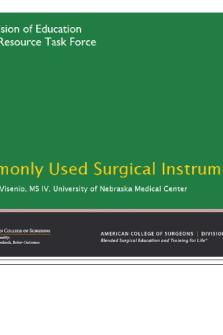Learning Module Care of the Surgical Patient(2) PDF

| Title | Learning Module Care of the Surgical Patient(2) |
|---|---|
| Author | chris makundu |
| Course | Medical-Surgical Nursing |
| Institution | University of Rhode Island |
| Pages | 3 |
| File Size | 134 KB |
| File Type | |
| Total Downloads | 16 |
| Total Views | 126 |
Summary
Med Sure II...
Description
Page 1 of 3 Neumann University-Undergraduate Nursing Nursing ___306____ Topic/Content__Perioperative Nursing__ Content Hours ______2_______________
Learning Module # __4___
Learning Outcomes
The Student Will: 1. Differentiate the common settings for surgical procedures.
Total Exam Items 9-11
Essential Learning Tools (Readings, labs, simulations, assignments, projects, clinical. Alternative Instructional Equivalencies by Hour should be included as per catalog)
Perioperative Nursing-Preoperative Phase I. Caring for the pre-surgical patient A. Nursing practice standards B. Surgical categories and settings
2. Describe the purpose and components of a preoperative nursing assessment.
II.
4. Discuss the nurse’s role in the physical, psychosocial, and educational preparation of the surgical patient.
III.
5. Identify the special
Content (Major Headings Bolded)
Nursing Assessment of the Preoperative Patient. A. Subjective data 1. Psychosocial assessment 2. Past health history 3. Medications 4. Review of systems B. Objective data 1. Physical examination 2. Diagnostic studies (Table 17-5) Nursing Management of the Preoperative Patient A. Preoperative teaching 1. Principles of pre-operative teaching 2. General surgery information 3. Ambulatory surgery information B. Legal preparation for surgery C. Informed consent D. Day of surgery preparation E. Pre-operative medications (Table 17-8) 1. Benzodiazepines 2. Opioids 3. Antibiotics (Per S.C.I.P Guidelines, see p. 315) 4. Anticholinergics
Lewis, Bucher, Heitkemper, Harding. (2017). Medical-Surgical Nursing .Ch. 17 and 18 ANA Code of Ethics-Bring Code of Ethics Book to Class
Joint Commission Documents: National Patient Safety Goals, 2016 https://www.jointcommission.org/assets/1/6/20 16_NPSG_HAP_ER.pdf Surgical Care Improvement Project-Core Measures http://www.jointcommission.org/assets/1/6/Surgic al%20Care%20Improvement%20Project.pdf WHO Guidelines for Safe Surgery http://www.who.int/patientsafety/safesurgery/tool s_resources/SSSL_Checklist_finalJun08.pdf? ua=1 All above are also on Course Blackboard Sample Pre-operative Checklist-See course Blackboard
Page 2 of 3 considerations of preoperative preparation for the patient from another culture and the older adult surgical patient 6. Identify the importance of the National Patient Safety Goals and SCIP in the provision of safe and effective care
6. Identify the roles and responsibilities of the interdisciplinary surgical team.
7. Discuss the various types of anesthesia used during surgical procedures and their possible effects on the patient postoperatively.
F. Safe transportation to the operating room G. Communication between pre-op RN and surgical RN. IV. V. VI. 9-11
Culturally competent care Gerontologic considerations
Perioperative Nursing-Intraoperative Phase I. II. III.
Caring for the patient in surgery The operating environment Safety guidelines for the perioperative setting A. Surgical Care Improvement Project (SCIP) B. WHO Guidelines for Safe Surgery C. National Patient Safety Goals (NPSG)
IV.
The surgical team A. Perioperative nurses 1. Circulating role-usually an RN 2. Scrub role-LPN, technologist) B. Surgeon and assistants (RN, MD, or PA) C. Anesthesia care providers 1. Anesthesiologist (MD) 2. Nurse anesthetist (CRNA)
V.
Nursing management prior to surgery (holding area)
VI.
Nursing management of patient during surgery
VII.
Anesthesia A. General 1. Intravenous induction agents 2. Inhalation agents 3. Other meds (Table 18-7) (a) Benzodiazepines (b) Opioids (c) Skeletal muscle relaxants (d) Antiemetics
BMP (Basic Metabolic Panel)-view https://www.youtube.com/watch? v=kRqBnfMs8bM
Page 3 of 3
B. C. D. E.
8. Using the Code of Ethics as a guide, discuss the responsibility of the perioperative nurse to the sedated patient.
VIII. IX.
(e) Reversal agents Local Regional Spinal and Epidural Anesthesia Anesthesia emergencies 1. Anaphylactic reactions 2. Malignant hyperthermia
Case Study and Discussion Transfer to PACU for further care
Case Study-ANA Code of Ethics with Interpretive Statements-see Provisions. Bring booklet to class
Date Developed: Aug 5, 2013 Date of Revisions::Aug 14, Jan15, Sept 15, Jan 31,16, Jan.8, 2017, Dec., 2018 Initials of Responsible Faculty: JP...
Similar Free PDFs

K to 12 nail care learning module
- 124 Pages

Assessment OF Learning 1 Module
- 67 Pages

Care of the elderly
- 8 Pages

The Science of Learning
- 7 Pages

Learning- Module Buscor Module 5
- 20 Pages

LAW OF Contract E- Learning Module
- 196 Pages

Module 2: Learning (Paxton)
- 9 Pages

Learning Module 1
- 4 Pages

cookery g10 learning module
- 402 Pages

Module Learning Outcome 1
- 3 Pages

Chapter 3 Learning Module
- 4 Pages

Module 14 Learning Objectives
- 1 Pages
Popular Institutions
- Tinajero National High School - Annex
- Politeknik Caltex Riau
- Yokohama City University
- SGT University
- University of Al-Qadisiyah
- Divine Word College of Vigan
- Techniek College Rotterdam
- Universidade de Santiago
- Universiti Teknologi MARA Cawangan Johor Kampus Pasir Gudang
- Poltekkes Kemenkes Yogyakarta
- Baguio City National High School
- Colegio san marcos
- preparatoria uno
- Centro de Bachillerato Tecnológico Industrial y de Servicios No. 107
- Dalian Maritime University
- Quang Trung Secondary School
- Colegio Tecnológico en Informática
- Corporación Regional de Educación Superior
- Grupo CEDVA
- Dar Al Uloom University
- Centro de Estudios Preuniversitarios de la Universidad Nacional de Ingeniería
- 上智大学
- Aakash International School, Nuna Majara
- San Felipe Neri Catholic School
- Kang Chiao International School - New Taipei City
- Misamis Occidental National High School
- Institución Educativa Escuela Normal Juan Ladrilleros
- Kolehiyo ng Pantukan
- Batanes State College
- Instituto Continental
- Sekolah Menengah Kejuruan Kesehatan Kaltara (Tarakan)
- Colegio de La Inmaculada Concepcion - Cebu



